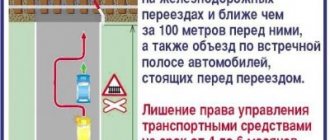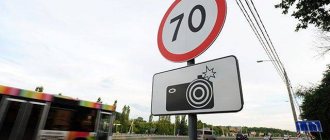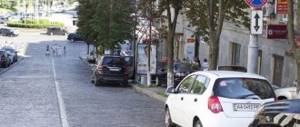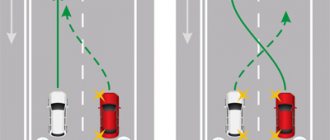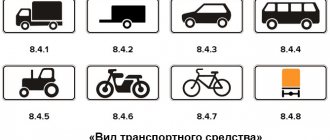Stopping and parking - the difference
The essence of both concepts is that the driver stops the car. The difference is in the duration and purpose of this “standing”. The stop has a specific purpose, for example, to let a passenger out or to go to the store. Therefore, the stop time is short - up to five minutes or more, if it is necessary to board (disembark) passengers and load (unload) the car. Anything longer than this time is considered parking by traffic regulations. These are the cases when your car is parked near your work during the day or near your home at night. And the parking lot has no purpose as such. The car is just waiting for its owner.
You can stop or park your car on the right side of the road - on the roadway or on the side of the road. But you need to be careful. The traffic rules contain a list of places where, in principle, you cannot stop or park a car. These bans exist to protect all road users and avoid accidents.
Features of stopping before crossing roads: tips for the driver
The rules for stopping before crossing roads are indicated in clause 6, as well as clause 13 of the traffic rules. In this case, the driver’s actions depend on the type of intersection. There are 2 types in total - regulated and unregulated.
At the same time, despite a fairly clear statement of the requirements for traffic on the roadway, car owners often encounter difficulties. Especially stopping before an intersection and generally moving around it is difficult for novice drivers.
In order not to break the rules and successfully drive through such a section, while slowing down in the right place, you will need to act as follows:
- determine the travel option - entering or exiting the intersection;
- change lanes;
- find out the type of intersection you are crossing - from here it will become clear where exactly you should stop;
- follow the signs placed and depicted on the road surface.
Carrying out the listed actions, and in general, knowledge of traffic regulations will help you comply with safety standards and prevent emergency situations.
Where you can't stop
Places where you should not stop include:
- left side of the road (exception: single-lane road in a populated area);
- sidewalk;
- pedestrian crossings (on them or close to them - less than five meters);
- bike paths;
- railway crossings;
- tram rails;
- bridges (if there are less than three lanes in your direction);
- overpasses (on and under them);
- intersections and the distance less than five meters from them;
- roads near sharp, dangerous turns, where a car coming around the turn will have difficulty seeing a stopped car;
- narrow roads (or lanes of roads) - between the car and the opposite edge of the road (or marking line) is less than three meters;
- tunnels;
- any places where a stopped car will interfere with traffic: blocking the passage, traffic lights, road signs;
- under the "No Stopping" sign.
Is stopping at a road intersection allowed?
If you need to stop on intersecting road sections, the main thing is not to go to the intersection itself, or to the pedestrian zebra crossing. This is prohibited by clause 12.4 of the traffic rules. You should brake more than 5 m before the road you are crossing.
The exception includes the sides opposite the side passages of three-way intersections. In particular, if they have a dividing strip or a continuous marking line.
According to clause 12.5 of the Rules, parking of vehicles at road intersections is also not allowed. In this case, a forced stop falls into the category of exceptions. For example, due to a malfunction of the car, unfavorable condition of the driver or passenger, or when an obstacle appears on the roadway.
However, stopping behind the intersection is permitted. After leaving the intersection, parking the car is allowed in accordance with the general requirements and parking rules (clause 12 of the traffic rules).
No Parking Sign
The "No Parking" sign is a blue circle bordered by a wide red border with a thin white outline bordering the colors. There is a red stripe running diagonally in the middle of the circle.
A sign with one diagonal stripe prohibits parking
Stopping and parking signs are very similar, so beginners can easily confuse them.
This has happened to me. To remember, I came up with such an association for myself. “OstZ” prohibits two actions: stopping and parking, so there are two red stripes on the sign, and “StoZ” prohibits one action (parking), which means there is only one red stripe. And my friend came up with another way to remember - by the first letters of the prohibited action: C and O. If you use your imagination, then there are clue letters on both signs. On “StoZ” the line divides the sign so that you get two letters C, looking at each other. This means that this sign prohibits parking. On “OstZ” you get the letter O (albeit with a cross inside). This means stopping is prohibited.
Penalties for illegal stopping and parking
For violations of parking/stopping rules, the Code of Administrative Offenses (hereinafter referred to as the Code of Administrative Offenses of the Russian Federation) provides for two main penalties: a fine and detention of the vehicle.
Fine
The Code of Administrative Offenses of the Russian Federation contains quite a few fines for non-compliance with Chapter 12 of the Traffic Regulations “Stopping and Parking”. They concern various violations in this area. The fine for stopping near the sign, i.e. in the prohibited zone, is prescribed in Article 12.16 of the Code of Administrative Offenses of the Russian Federation. It is equal to 1,500 rubles for all of Russia and 3,000 rubles for Moscow and St. Petersburg.
For other violations of parking/stopping rules, the state has established the following fines (and sometimes in addition other penalties):
- for stopping on a lane for fixed-route transport - 1,500 rubles, for Moscow and St. Petersburg - 3,000 rubles;
- for stopping/parking at a pedestrian crossing - 1000 rubles, in Moscow and St. Petersburg - 3000 rubles;
- for stopping/parking at a public transport stop - 1000 rubles, for Moscow and St. Petersburg - 3000 rubles;
- for stopping/parking on tram tracks - 1500 rubles, in Moscow and St. Petersburg - 3000 rubles;
- for stopping/parking on the roadway so that the car interferes with traffic - 2000 rubles, for Moscow and St. Petersburg - 3000 rubles;
- for stopping/parking at a railway crossing - 1000 rubles. or deprivation of a Sikh driver's license for six months;
- for stopping/parking in places for disabled people - 5,000 rubles;
- for violation of all other “minor” rules from Chapter 12 of the Traffic Regulations (for example, driving onto the sidewalk) - a warning or a fine of 500 rubles, in Moscow and St. Petersburg - 2500 rubles.
About all this - article 12.19 of the Code of Administrative Offenses of the Russian Federation.
Video: controversial situation with violation of parking rules
Discount on fine
If you hurry, you can pay not the entire fine, but only half of it. In the first 20 days after the resolution is drawn up and a fine is imposed, the violator has a 50% discount provided by law.
Car detention
If the car is parked under a prohibitory sign or in the zone of influence of such a sign, it can be taken to the impound lot (for a violation under Article 12.16 of the Administrative Code). But here you need to keep in mind: the fact that a tow truck is working should be warned by an additional information sign hanging under “OstZ” or “StoZ”.
You can take your car to the impound lot only if a special sign warns you about it.
In order to detain a car (that’s what this whole procedure with a tow truck is called), you need to draw up a protocol. Ideally, you should be present when it is compiled. But they can do this without you - they will record it on video or invite two witnesses. The protocol will indicate which rule you violated and will give you a punishment: a fine for illegal parking + detention of the car.
After the protocol, the car is taken away. How, when, who does this - these questions are answered by the laws of a specific region of the Russian Federation. That is, this process can occur differently everywhere. The main thing is that there is a protocol. There is no protocol - there is no reason to take the car.
But the return of the car is the same for all regions. The owner of the vehicle must pay a fine, which is issued along with the detention, the cost of transportation and maintaining the vehicle in the parking lot. After that he can take it away. At the impound lot, of course, you will need to show documents confirming that the car is yours or you have the right to drive it (for example, a compulsory motor liability insurance policy).
If you successfully managed to run while the car was just being processed for detention, and corrected your violation, for example, parked under a parking sign, and not under the “StoZ” sign, then the car will no longer be taken away. But before you fix it, you will need to confirm that the car is yours. Therefore, let the documents for the car always be with you, even if you left it for a short time.
A friend of mine left the car under a prohibitory sign. There was nowhere to park, and here, where he arrived, there was only half an hour to do. I decided that maybe it would pass. When the friend returned to the car, it had already been sealed and was about to be loaded onto a tow truck. The acquaintance, of course, ran up like a bullet: “Please don’t take it, I’m already leaving.” They ask him for documents confirming that the car is his. And the documents are in the car - my friend left for a while. Naturally, he didn’t show anything, and a sealed car cannot be opened without an inspector. (Cars are taken to the impound lot not by the State Traffic Safety Inspectorate, but by the Traffic Management Center, so there is no inspector during the arrest). And they took the swallow to the impound lot. On the same day, an acquaintance went to rescue the car. As you can imagine, the procedure became a little more complicated for him. I had to fill out a form stating that the car needed to be opened to remove documents. And after that, together with the inspector, open the car and take the documents. When everyone was convinced that my friend was the owner of the car, he paid the fine (with a 50 percent discount), transportation and maintenance of the car in the parking lot. Considering that the car did not sit there for even a day, the costs were relatively small (about 5,000 rubles: 3,000 rubles fine + other expenses). But the lesson was remembered for the rest of my life.
LOCATION AND ARRANGEMENT OF PUBLIC TRANSPORT STOPS
Single stops, including combined stops (bus and trolleybus), are arranged provided that the total frequency of movement of route vehicles using one stop does not exceed 30 units/hour; double – when several routes of the same type of vehicles are served with a total traffic frequency of more than 30 units/hour. If the frequency of buses and trolleybuses is more than 30 units/hour, their stops should be dispersed: a trolleybus stop should be located, followed by a bus stop; the distance between their landing sites must be at least 10 m.
Bus and trolleybus stops, as a rule, should be located behind intersections at a distance of at least 5 and 20 m, respectively, from the pedestrian crossing and intersection to the landing area.
As an exception, the placement of bus and trolleybus stops is allowed at the intersection of streets and roads in cases where:
— before the intersection there is a large passenger-generating object or an entrance to an underground pedestrian crossing;
— the reserve capacity of the roadway (road) up to the intersection is greater than beyond it;
— after the intersection, the approach to the bridge, tunnel or overpass begins. In this case, the distance from the stop to the intersection must be at least 20 m.
The location of a bus or trolleybus stop can be ordinary with a constant width of the roadway or arranged, if possible, by widening the roadway in the form of an open “pocket” (separating “pockets” from the roadway by a curb or other obstacle to traffic is prohibited). The width of the “pocket” is assumed to be equal to the traffic lane, but not less than 3.5 m due to technical and dividing stripes between the roadway and the sidewalk, as well as green space strips, the length of the transition section at the entrance to the stop is 20 m, at the exit – 15 m (in limited conditions can be reduced to 10 m).
In cramped conditions, the width of the “pocket” can be reduced to 3 m and implemented at the expense of the sidewalk, if its remaining width ensures the normal functioning of the landing area and proper conditions for the movement of pedestrians along the sidewalk.
When placing a “pocket” behind an intersection at a distance of 10 m from the border of a pedestrian crossing, the expansion of the roadway should be arranged so that it begins at the intersection from its curvature (that is, without the entrance transition section of the “pocket”).
Tram stops must be located before the intersection of city streets and roads in front of the pedestrian crossing at a distance of at least 5 m from the intersection.
The length of the landing area is determined by the types and number of route vehicles simultaneously disembarking and picking up passengers at the stop, and should be taken in accordance with Table 1.
Table 1.
| Types of route vehicles | Landing area length, m |
| unit | double |
| Regular | |
| Articulated | |
| Twin | |
| Three-car | — |
The placement of public transport stops on squares is allowed when they have a significant reserve of roadway capacity, and the placed stops will not create obstacles to traffic flows.
At stops it is necessary to provide pavilions or canopies for passengers, which should not impair visibility for drivers or interfere with the movement of pedestrians (Fig. 5).
The distance between stopping points on public passenger transport lines within the territory of populated areas should be taken, m: for buses, trolleybuses and trams 400-600, express buses and high-speed trams 800-1200, metro 1000-1500, electrified railways 1500-2000 .
Figure 5. An example of placing a public transport stop with a canopy.
CAR PARKING AND GARAGES
The insufficient capacity of parking lots makes it impossible to provide normal transport services to residents, and the cluttering of streets with parked cars reduces traffic capacity and safety.
The level of motorization, the general need for places for permanent and temporary storage of cars, requirements for their placement in the entire settlement and its individual functional zones, as well as near residential and public buildings and structures, industrial and municipal warehouse facilities, distances from parking lots and garages to the objects surrounding them are accepted in accordance with DBN 360, Development Rules for a given locality, Sanitary legislation and other current regulatory documents.
Garage is a building (structure), part of a building (structure) or a complex of buildings (structures) with premises for permanent or temporary storage, as well as elements for the maintenance of cars and other motor vehicles.
The main type of garage in multi-storey residential buildings in cities is multi-storey garages, including those with a partially buried first floor or several built-in and attached underground floors. It is allowed to design free-standing underground or semi-underground garages (see Appendix 5).
The minimum required area of a specific site (territory) for permanent or temporary storage of cars in open parking lots is determined based on the norm of 25 m2 per rated car, and in garages, depending on their number of storeys, according to Table 2.
Table 2.
| Number of storeys of garages | Built-up area | Land size |
| for 1 parking space, m2 | ||
| 7-9 | ||
| Note 1. A category 1 vehicle with a length of up to 6 m and a width of up to 2.1 m is accepted as a design estimate. Note 2. The indicators given in the table also take into account the maneuvering area (the area of internal passages per vehicle storage location). |
Capacity of parking lots and garages, composition of facilities and area of premises for service personnel, including technical purposes, sanitary facilities, their space-planning solution, number of entrances and exits with one-way or two-way traffic and their placement in relation to city streets and courtyard driveways, the need to construct a storage area before the entrance and fencing the territory are determined by the design assignment, urban planning sanitary standards and these Standards.
At the same time, the parameters of parking spaces, driveways and space-planning solutions for garages and parking lots are determined by the dimensions of the cars for which the garage or parking lot is designed, the placement of cars (arrangement angle, number of storage rows) in relation to internal driveways, the smallest radii of their turns, as well as the proximity dimensions (protective zones) of the vehicle installed at the storage site to the structures of the building (structure), to the equipment and to other vehicles at the storage sites.
Depending on the number of storage spaces, there are parking lots and garages of small (up to 50 parking spaces), medium (from 50 to 300 parking spaces) and large (more than 300 parking spaces) capacity.
A parking lot is a specially equipped open area for permanent or temporary storage of cars and other motor vehicles.
Parking lots for permanent storage of cars should include open areas for parking cars, rooms for duty officers and storage of equipment, relevant elements of engineering equipment and landscaping, and also, if necessary and technically possible, there may be maintenance, technical repair and car washing posts, including self-service points - inspection pits (overpasses), places for cleaning the car interior. Such parking lots can be equipped with sun-protection canopies, wind-proof walls, and decorative sun-protection and noise-proof landscaping.
In parking lots for temporary storage of cars, if necessary and technically possible, self-service points, inspection pits (overpasses) are installed in specially designated areas, and a security alarm is installed.
When designing parking lots, the following regulatory parameters should be taken into account:
— the dimensions of one parking space in parking lots for storing medium-sized cars (taking into account the minimum permissible safety clearances of 0.5 m) are 2.5 x 5.3 m. For temporary parking lots, parking dimensions of 2.3 x 5.0 m are allowed. Safety clearances allowed to increase up to 0.7 m;
- minimum width of passages: two-way traffic - 6 m, one-way traffic - 3.5 m;
— radii of curvature of the side stone — not less than 6 m.
Note : When calculating the number of motorcycles that can be placed in parking lots, the following parking space dimensions are accepted: motorcycle with sidecar - 2.4 x 1.7 m, single motorcycle - 2.4 x 0.8 m, distance between motorcycles - at least 0.5 m.
Depending on the configuration and size of the parking lot, the organization of entry and exit, a single- or multi-row arrangement of cars can be adopted with the installation of cars on one side of the driveway and along both opposite sides, parallel, perpendicular or at an angle to the longitudinal axis of the driveway (see Appendix 6).
At the same time, the requirement of rational use of the allocated territory, ensuring the safety of traffic and pedestrians (separation of their directions of movement) within the site and on adjacent streets and driveways must be met.
After completing the construction work on the general plan of streets, roads and intra-block driveways, it is necessary to complete the graphic design of the drawing. It is recommended to draw the drawing with ink. This will allow you to clearly identify the gradation of the thickness of all lines, clearly indicate the numbers and remove unnecessary lines.

